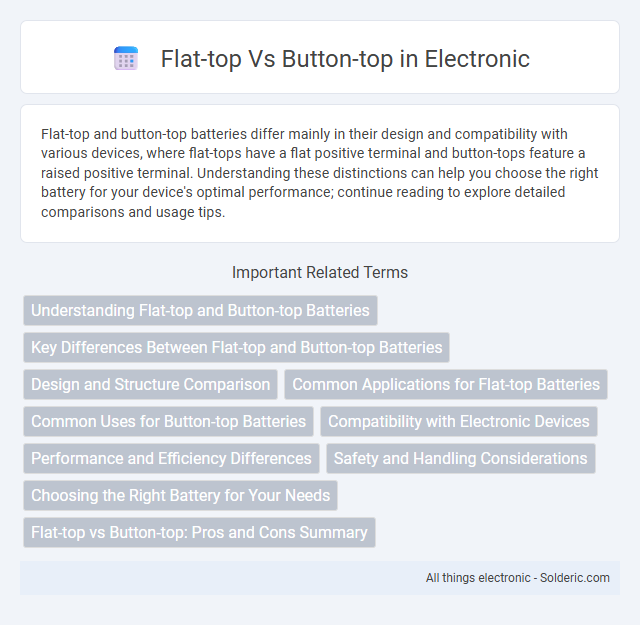Flat-top and button-top batteries differ mainly in their design and compatibility with various devices, where flat-tops have a flat positive terminal and button-tops feature a raised positive terminal. Understanding these distinctions can help you choose the right battery for your device's optimal performance; continue reading to explore detailed comparisons and usage tips.
Comparison Table
| Feature | Flat-top Battery | Button-top Battery |
|---|---|---|
| Design | Flat positive terminal, flush with battery casing | Raised positive terminal, protrudes from battery casing |
| Compatibility | Fits devices requiring flat contact points | Suited for devices needing protruding terminals for secure contact |
| Contact Reliability | May have less reliable contact in some battery holders | Provides more consistent and secure contact |
| Typical Use | High drain electronics, some flashlights and vaporizers | Most standard household electronics and flashlights |
| Safety | Less chance of short circuit due to flat design | Raised terminals can increase short circuit risk if improperly stored |
| Battery Types Commonly Available | 18650 flat-top Li-ion batteries | AA, AAA button-top alkaline and NiMH batteries |
Understanding Flat-top and Button-top Batteries
Flat-top and button-top batteries differ primarily in their physical design and compatibility with devices. Flat-top batteries have a flat positive terminal ideal for compact electronics and battery packs, while button-top batteries feature a protruding positive terminal, ensuring reliable contact in devices with spring-loaded battery compartments. Choosing the correct type involves verifying device specifications to prevent connectivity issues and optimize performance.
Key Differences Between Flat-top and Button-top Batteries
Flat-top batteries feature a smooth, level surface without a protruding positive terminal, making them compatible with devices designed for tight battery compartments or specific contact points. Button-top batteries, distinguished by their raised positive terminal, offer better contact reliability in many devices but may not fit in compact battery slots. Your choice between flat-top and button-top batteries depends on the device's design and required terminal contact type for optimal performance.
Design and Structure Comparison
Flat-top batteries feature a uniform, flat surface that allows for compact stacking and efficient use in battery packs, while button-top batteries have a protruding positive terminal designed to ensure better contact in certain device compartments. The flat-top design offers a sleek profile ideal for machinery requiring tight battery placement, whereas button-top batteries provide enhanced terminal security, preventing accidental disconnections. Understanding the design and structure differences helps you choose the appropriate battery type for your specific device requirements.
Common Applications for Flat-top Batteries
Flat-top batteries are commonly used in devices like flashlights, remote controls, and certain power tools due to their low-profile design that allows for efficient stacking and compact battery packs. Their stable, flat surface enables better contact in battery holders designed for series or parallel configurations, enhancing energy delivery in electronic devices. You will find flat-top batteries preferred in applications requiring consistent power output and streamlined battery compartments.
Common Uses for Button-top Batteries
Button-top batteries are commonly used in household electronics such as remote controls, flashlights, and portable audio devices due to their reliable connection and ease of handling. They are preferred in devices requiring secure battery placement and consistent power delivery, including wall clocks and wireless keyboards. This battery type suits applications where battery removal and replacement occur frequently, ensuring optimal contact and operational stability.
Compatibility with Electronic Devices
Flat-top and button-top batteries differ mainly in their terminal design, which affects compatibility with various electronic devices. Flat-top batteries have a flush, flat positive terminal, making them ideal for devices with tight battery compartments or flat contacts like laptops and some flashlights. Button-top batteries feature a protruding positive terminal, which fits devices such as remote controls or toys that require a raised contact point, ensuring your device receives a proper connection and optimal performance.
Performance and Efficiency Differences
Flat-top batteries generally offer higher energy density and better thermal management, leading to improved performance and efficiency in high-drain devices. Button-top batteries provide safer terminal protection and are often preferred in applications requiring reliable contact and reduced risk of short circuits. Your choice depends on device compatibility and whether maximizing battery runtime or ensuring safe operation is the priority.
Safety and Handling Considerations
Flat-top batteries offer enhanced safety with their consistent height, reducing the risk of short circuits when installed in series or parallel configurations. Button-top batteries, featuring protruding positive terminals, provide easier handling and clearer polarity identification, minimizing the chance of incorrect insertion. When choosing your battery type, consider how these characteristics impact safe installation and handling in your specific device or application.
Choosing the Right Battery for Your Needs
Choosing the right battery for your needs depends on understanding the differences between flat-top and button-top batteries. Flat-top batteries offer a flush surface ideal for devices requiring tight battery compartments, while button-top batteries have protruding terminals that ensure more reliable connections in certain electronics like flashlights or RC toys. Assess your device's battery contacts and performance demands to determine whether a flat-top or button-top battery best suits your power requirements.
Flat-top vs Button-top: Pros and Cons Summary
Flat-top batteries offer a lower profile and easier stacking in devices, enhancing stability and reducing space usage; however, their design can limit compatibility with certain battery compartments. Button-top batteries provide a raised contact point, ensuring better connectivity in devices requiring this feature, but they may add bulk and complicate fitting in tight spaces. Choosing between flat-top and button-top batteries depends on device requirements, with flat-tops favored for compact, flat-contact slots and button-tops preferred for devices needing a protruding positive terminal.
Flat-top vs Button-top Infographic

 solderic.com
solderic.com